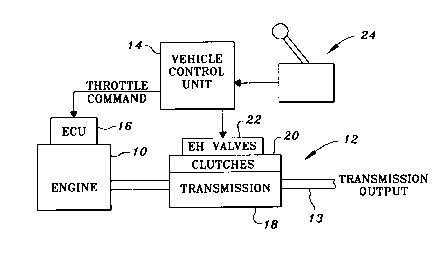Une partie des informations de ce site Web a été fournie par des sources externes. Le gouvernement du Canada n'assume aucune responsabilité concernant la précision, l'actualité ou la fiabilité des informations fournies par les sources externes. Les utilisateurs qui désirent employer cette information devraient consulter directement la source des informations. Le contenu fourni par les sources externes n'est pas assujetti aux exigences sur les langues officielles, la protection des renseignements personnels et l'accessibilité.
L'apparition de différences dans le texte et l'image des Revendications et de l'Abrégé dépend du moment auquel le document est publié. Les textes des Revendications et de l'Abrégé sont affichés :
| (12) Demande de brevet: | (11) CA 2302786 |
|---|---|
| (54) Titre français: | COMMANDE DE GAZ DU MOTEUR POUR DES CHANGEMENTS DE VITESSE AMELIORES |
| (54) Titre anglais: | ENGINE THROTTLE CONTROL FOR IMPROVED SHIFTING |
| Statut: | Réputée abandonnée et au-delà du délai pour le rétablissement - en attente de la réponse à l’avis de communication rejetée |
| (51) Classification internationale des brevets (CIB): |
|
|---|---|
| (72) Inventeurs : |
|
| (73) Titulaires : |
|
| (71) Demandeurs : |
|
| (74) Agent: | BORDEN LADNER GERVAIS LLP |
| (74) Co-agent: | |
| (45) Délivré: | |
| (22) Date de dépôt: | 2000-03-28 |
| (41) Mise à la disponibilité du public: | 2001-05-29 |
| Requête d'examen: | 2000-03-28 |
| Licence disponible: | S.O. |
| Cédé au domaine public: | S.O. |
| (25) Langue des documents déposés: | Anglais |
| Traité de coopération en matière de brevets (PCT): | Non |
|---|
| (30) Données de priorité de la demande: | ||||||
|---|---|---|---|---|---|---|
|
A vehicle includes a powershift transmission driven by an electronically
controlled
engine. A control system momentarily modifies a magnitude of an engine
throttle command
signal during a shift of the power shift transmission in order to make the
shift smoother and
less sensitive to achieving optimum clutch engagement pressure. It also
prevents an engine
governor from over-reacting and causing rough shifts.
Note : Les revendications sont présentées dans la langue officielle dans laquelle elles ont été soumises.
Note : Les descriptions sont présentées dans la langue officielle dans laquelle elles ont été soumises.

2024-08-01 : Dans le cadre de la transition vers les Brevets de nouvelle génération (BNG), la base de données sur les brevets canadiens (BDBC) contient désormais un Historique d'événement plus détaillé, qui reproduit le Journal des événements de notre nouvelle solution interne.
Veuillez noter que les événements débutant par « Inactive : » se réfèrent à des événements qui ne sont plus utilisés dans notre nouvelle solution interne.
Pour une meilleure compréhension de l'état de la demande ou brevet qui figure sur cette page, la rubrique Mise en garde , et les descriptions de Brevet , Historique d'événement , Taxes périodiques et Historique des paiements devraient être consultées.
| Description | Date |
|---|---|
| Inactive : CIB désactivée | 2011-07-29 |
| Inactive : CIB de MCD | 2006-03-12 |
| Inactive : CIB dérivée en 1re pos. est < | 2006-03-12 |
| Inactive : CIB de MCD | 2006-03-12 |
| Inactive : CIB de MCD | 2006-03-12 |
| Inactive : CIB de MCD | 2006-03-12 |
| Demande non rétablie avant l'échéance | 2005-06-06 |
| Inactive : Morte - Aucune rép. dem. par.30(2) Règles | 2005-06-06 |
| Réputée abandonnée - omission de répondre à un avis sur les taxes pour le maintien en état | 2005-03-29 |
| Inactive : Abandon. - Aucune rép dem par.30(2) Règles | 2004-06-07 |
| Inactive : Dem. de l'examinateur par.30(2) Règles | 2003-12-05 |
| Modification reçue - modification volontaire | 2003-08-14 |
| Inactive : Dem. de l'examinateur par.30(2) Règles | 2003-03-12 |
| Modification reçue - modification volontaire | 2002-06-27 |
| Inactive : Page couverture publiée | 2001-05-30 |
| Demande publiée (accessible au public) | 2001-05-29 |
| Inactive : CIB en 1re position | 2000-05-17 |
| Inactive : CIB attribuée | 2000-05-17 |
| Inactive : CIB attribuée | 2000-05-17 |
| Inactive : Certificat de dépôt - RE (Anglais) | 2000-04-26 |
| Exigences de dépôt - jugé conforme | 2000-04-26 |
| Lettre envoyée | 2000-04-26 |
| Demande reçue - nationale ordinaire | 2000-04-25 |
| Exigences pour une requête d'examen - jugée conforme | 2000-03-28 |
| Toutes les exigences pour l'examen - jugée conforme | 2000-03-28 |
| Date d'abandonnement | Raison | Date de rétablissement |
|---|---|---|
| 2005-03-29 |
Le dernier paiement a été reçu le 2004-03-04
Avis : Si le paiement en totalité n'a pas été reçu au plus tard à la date indiquée, une taxe supplémentaire peut être imposée, soit une des taxes suivantes :
Veuillez vous référer à la page web des taxes sur les brevets de l'OPIC pour voir tous les montants actuels des taxes.
| Type de taxes | Anniversaire | Échéance | Date payée |
|---|---|---|---|
| Requête d'examen - générale | 2000-03-28 | ||
| Enregistrement d'un document | 2000-03-28 | ||
| Taxe pour le dépôt - générale | 2000-03-28 | ||
| TM (demande, 2e anniv.) - générale | 02 | 2002-03-28 | 2002-03-27 |
| TM (demande, 3e anniv.) - générale | 03 | 2003-03-28 | 2003-03-27 |
| TM (demande, 4e anniv.) - générale | 04 | 2004-03-29 | 2004-03-04 |
Les titulaires actuels et antérieures au dossier sont affichés en ordre alphabétique.
| Titulaires actuels au dossier |
|---|
| DEERE & COMPANY |
| Titulaires antérieures au dossier |
|---|
| DUANE FREDRICK MEYER |